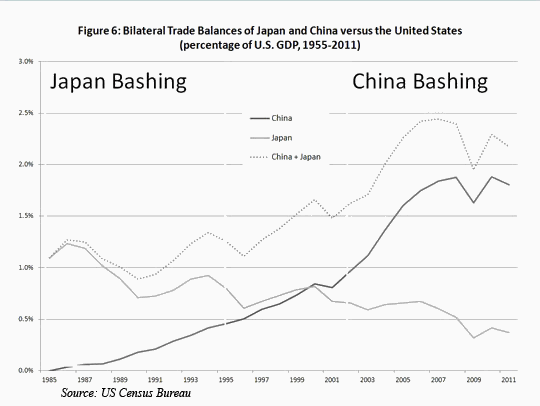
Since World War II’s end, the US dollar has been used to invoice most global trade, serving as the intermediary currency for clearing international payments among banks and dominating official foreign-exchange reserves. This arrangement has often been criticized, but is there any viable alternative?
The problem for post-WWII Europe, mired in depression and inflation, was that it lacked foreign reserves, which meant that trade carried a high opportunity cost. To facilitate trade without requiring payment after each transaction, the Organization for European Economic Cooperation created the European Payments Union in 1950.
Supported by a dollar-denominated line of credit, the EPU’s 15 Western European member states established exact dollar exchange-rate parities as a prelude to anchoring their domestic price levels and removing all currency restrictions on intra-European trade. This formed the keystone of the hugely successful European Recovery Program (the Marshall Plan), through which the US helped to rebuild Europe’s economies.
Today, most developing economies, with the exception of a few Eastern European countries, still choose to anchor their domestic macroeconomic arrangements by stabilizing their exchange rates against the dollar, at least intermittently. Meanwhile, to avoid exchange-rate conflict, the US Federal Reserve typically stays out of the currency markets.
But the dollar’s role as international anchor is beginning to falter, as emerging markets everywhere grow increasingly frustrated by the Fed’s near-zero interest-rate policy, which has caused a flood of “hot” capital inflows from the US. That, in turn, has fueled sharp exchange-rate appreciation and a loss of international competitiveness – unless the affected central banks intervene to buy dollars.
Indeed, since late 2003, when the Fed first cut interest rates to 1%, triggering the US housing bubble, dollar reserves in emerging markets have increased six-fold, reaching $7 trillion by 2011. The resulting expansion in emerging markets’ monetary base has led to much higher inflation in these countries than in the US, and to global commodity-price bubbles, particularly for oil and staple foods.
But the US is also unhappy with the way the dollar standard is functioning. Whereas other countries can choose to intervene in order to stabilize their exchange rates with the world’s principal reserve currency, the US, in order to maintain consistency in rate setting, does not have the option to intervene, and lacks its own exchange-rate policy.
Moreover, the US protests other countries’ exchange-rate policies. Two decades ago, the US pressed the Japanese to allow the yen to strengthen against the dollar, claiming that Japan’s unfair exchange-rate policies were responsible for America’s ballooning bilateral trade deficit. Likewise, today’s “China-bashing” in the US – which has intensified as China’s contribution to America’s trade deficit has soared – is intended to force the Chinese authorities to allow faster renminbi appreciation.

Herein lies the great paradox. Although no one likes the dollar standard, governments and private market participants still consider it the best option.
In fact, US trade deficits are primarily the result of insufficient, mainly government, saving – not a misaligned exchange rate, as economists have led policymakers to believe. Large US budget deficits during Ronald Reagan’s presidency generated the famous twin fiscal and trade deficits of the 1980’s. This, not an undervalued yen, caused the bilateral deficit with Japan to widen in the 1980’s and 1990’s.
The much larger US fiscal deficits of the new millennium, courtesy of Presidents George W. Bush and Barack Obama, portend large – and indefinite – trade deficits. But American policymakers continue to blame China, claiming that the renminbi has been undervalued for the last decade.
The claim that exchange-rate appreciation will reduce a country’s trade surplus is false, because, in globally integrated economies, domestic investment falls when the exchange rate appreciates. So the ill will that China-bashing is generating is for nothing. Worse, it detracts political attention from America’s huge fiscal deficit – $1.2 trillion (7.7% of GDP in 2012 – and thus impedes any serious effort to rein in future spending for entitlements, such as health care and pensions.
Some contend that large fiscal deficits do not matter if the US can exploit its central position under the dollar standard – that is, if it finances its deficits by selling Treasury bonds to foreign central banks at near-zero interest rates. But America’s ongoing trade deficits with highly industrialized countries, particularly in Asia, are accelerating de-industrialization in the US, while providing fodder for American protectionists.
Indeed, America’s trade deficit in manufactures is roughly equal to its current-account deficit (the amount by which domestic investment exceeds domestic saving). So those concerned with job losses in US manufacturing should join the chorus lobbying for a much smaller fiscal deficit.
Can large US fiscal deficits and near-zero interest rates be justified because they help to revive domestic economic growth and job creation? Five years after the credit crunch of 2007-2008, it seems that they cannot. And, without even that justification, the latest wave of criticism of the US dollar standard appears set to rise further – and to stimulate the search for a “new” arrangement.
But the best new arrangement – and possibly the only feasible one – would follow an old formula: As in the 1950’s and 1960’s, the US would set moderately positive and stable interest rates, with sufficient domestic saving to generate a (small) trade surplus. The cooperation of China, now the world’s largest exporter and US creditor, is essential for easing and encouraging the transition to this nirvana. Apart from the ongoing euro crisis, a stable renminbi/dollar exchange rate is the key to renewed (dollar) exchange-rate stability throughout Asia and Latin America – as envisaged in the original 1944 Bretton Woods Agreement.
© 2013 Project Syndicate.

